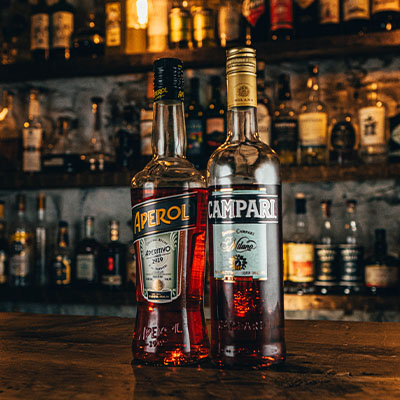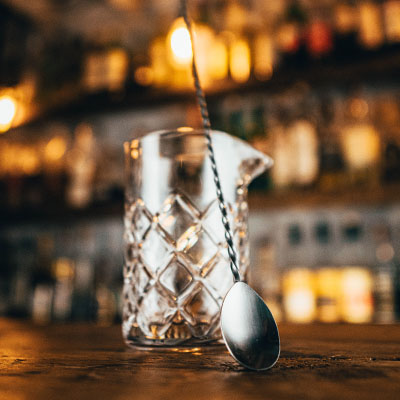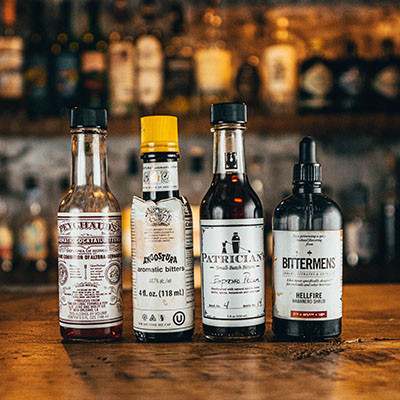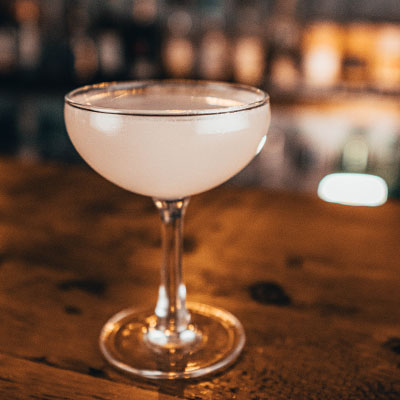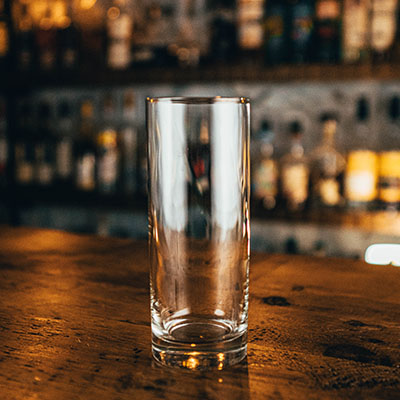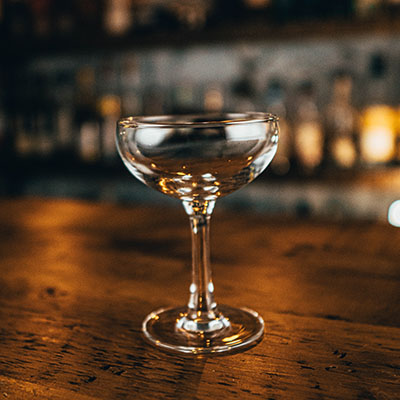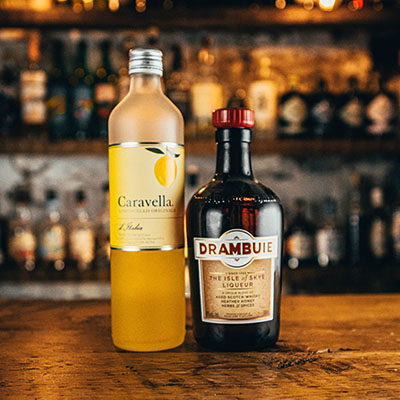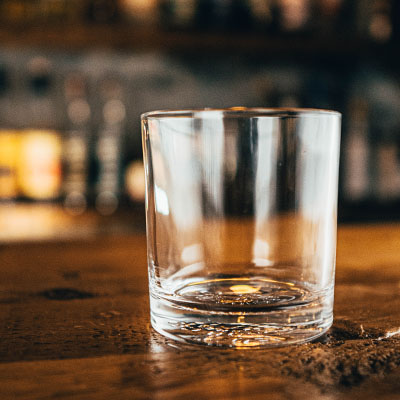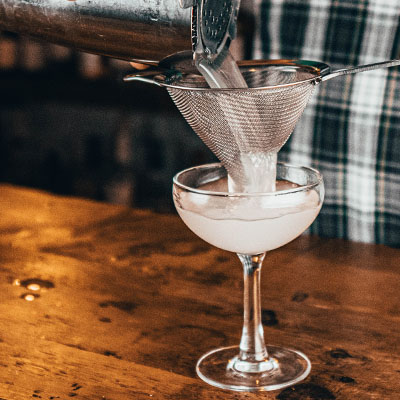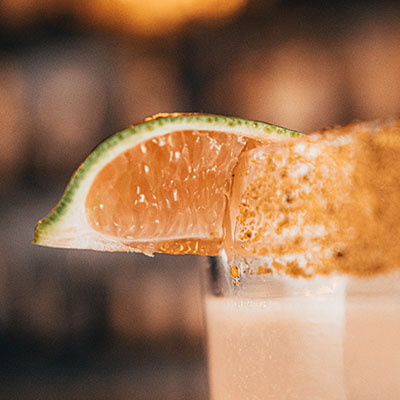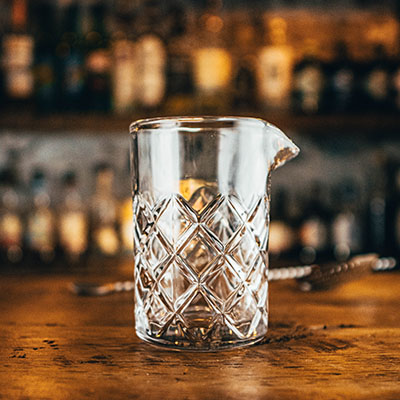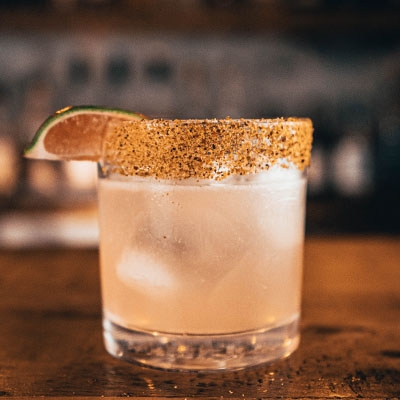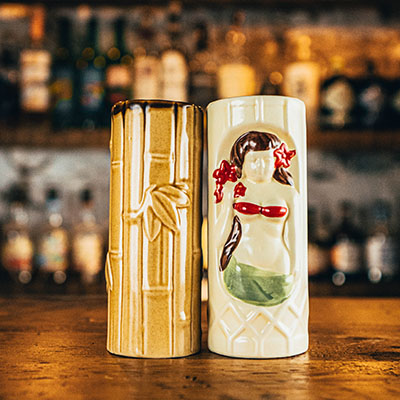Are you a bartender just starting? Or do you just want to improve your home skills? Just like with any industry, a lot of jargon comes with working in the service industry. So, we’ve compiled a list of some of the most essential bartender terms for beginning bartenders to know.
Consider this the ultimate cheat sheet. All the vocabulary you need to know to grasp the basics of bartending is right here.
What Bartender Terms Do I Need To Know?
-
50% rule
The proper time to serve customers the next cocktail is once they’ve consumed 50% of their drink. This is an excellent marker to provide attentive service and avoid over-serving.
-
86
An item that has been 86’d is no longer available to be served or sold.
-
A.B.V.
Alcohol by Volume is a standard measurement of alcohol (ethanol) content in beer, spirit, or other alcoholic products. More specifically, it is how many milliliters (mL) of pure ethanol is in 100 mL of the product.
-
Angel’s Share
Some evaporation occurs when a spirit is aged in barrels, leaving the final volume in the barrel less than what went in. That evaporated spirit is referred to as Angel’s Share.
-
Aperitif
A beverage, usually alcoholic, is consumed at the start of a meal to stimulate the appetite. It also refers to specific spirits characterized by their bitterness, including Campari and Aperol, to name a few. They are also known as an aperitivo.
Aperitif – Aperol and Campari -
Back
A beverage that accompanies and is consumed after a stiffer drink, usually a shot. A back can be anything from water to beer or juice. A popular order is a whiskey shot with a pickle back.
-
Bar Spoon
A tool that is used to mix, chill, and dilute cocktails in a mixing glass. Most bar spoons are between 12 and 15 inches long and have a spiralized pattern on the handle. They also can be used to help layer drinks.
Bar Spoon -
Barback
A person who is in charge of many different jobs behind the bar, including but not limited to; washing glassware, cleaning up spills, prepping garnishes and juices, cutting fruit, getting ice, changing beer kegs, etc.
Barbacks are there to help the bartenders make drinks quickly and efficiently by making sure they have everything they need. One of the easiest ways to be promoted to a bartender is to start out as a kick-ass barback. As a barback, you can learn about equipment, ingredients, and movement behind the bar.
-
Bitters
A neutral spirit infused with herbs, spices, botanicals, bark, roots, and a plethora of other flavorful ingredients. Bitters are used to add flavor, depth, and dimension to a cocktail and can also help balance a cocktail. Common brands include Angostura, Peychaud’s, and Fee Brothers.
121 Bartender Terms: The Ultimate Bar Cheat Sheet 2024 16 -
Blend
Mixing up ingredients in a blender. Common blended drinks include margaritas and daiquiris.
-
Box
To pour a drink from one tin of a shaker to the other. This is done one time. Similar to rolling.
-
Bruised
When a spirit is shaken too long and leaves a cloudy look. This is mostly associated with gin martinis that are shaken.
-
Build
Pouring the ingredients of a cocktail right into the glass in which it is served. For example, a Long Island Iced Tea is usually built in glass.
-
Build-in-Glass
When all the ingredients of a cocktail are added to and often stirred in, the glass in which it is served without the use of equipment like shaker tins or mixing glass.
-
Burnt.
Martinis made with a little bit of Scotch added.
-
Buy Back
When a bartender buys a customer a drink.
-
Call Drink
When a customer orders a drink and uses the specific name of liquor and a mixer. For example Beefeater and tonic or Tito’s and soda.
-
Chaser
Something non-alcoholic that is consumed right after drinking a shot or neat pour of a spirit. Similar to a back.
-
Chill
Add ice and sometimes water to stem glassware to lower the temperature of the glass. You do this prior to mixing the cocktail. Before you pour the drink into the glass, you dump the ice and water out. The purpose of chilling a glass is to keep the drink at the ideal drinking temperature for as long as possible.
-
Classic Cocktail
A cocktail created after 1887, “Jerry Thomas’ Bar-Tender’s Guide” was published. These cocktails are time-honored, easy to make, and universally known. For example, the Martini, Manhattan, Old Fashioned, and Gimlet can be considered classic cocktails.
Classic Cocktail – Gimlet -
Cobbler
A shaken cocktail that contains a combination of spirit, sugar, crushed ice, and fruit with fruit and mint as garnish. Sherry is traditionally the base, but spirits have also been used in modern variations. Original cobbler drinks did not have fruit juice in them,
-
Cocktail
A drink containing one or more spirits with sometimes the addition of modifiers, juices, and syrups.
-
Cocktail Station
Under bar equipment that holds everything you need to quickly prepare cocktails in a small, organized space. Cocktail, or bar stations, often include ice bins, garnish stations, sinks, speed rails, equipment holders, and spaces to store syrups.
-
Collins
A drink that is served in a tall glass, consisting of a base spirit (usually gin), lemon juice, sugar, and soda water.
121 Bartender Terms: The Ultimate Bar Cheat Sheet 2024 17 -
Comp
When the bartender takes responsibility for all or part of the customer’s bill.
-
Coupe
A style of glassware with a stem. Coupes have a wide mouth opening and shallow depth. Common cocktails that are served in this glass include Whiskey Sours, Gimlets, and the Manhattan.
Coupe Glass, 5.5 oz, Clear -
Crusta
One of the first styles of cocktail to be considered a sour, which contain a spirit, sugar, lemon juice, and aromatic bitters. Today the main spirits used are either cognac or brandy, but sometimes bourbon or rye are used.
-
Daisy
A family of sour cocktails that contain a spirit, citrus juice, and sweetener. Served over crushed ice, these cocktails are usually oversized. They can be sweetened with sugar, syrup, fruit syrup, or liqueurs.
-
Dash
A few drops of an ingredient. Usually associated with measurements of bitters. Usually somewhere between 1/8 and 1/4 teaspoon.
-
Dead Stock
Inventory that is not selling.
-
Devil’s Cut
When a spirit is aged in barrels, the amount of the spirit that is absorbed into the barrels and cannot be extracted when bottling.
-
Digestif
A drink or spirit which is served after dinner to aid with digestion. Examples are any one of the Amari family of liqueurs, Sambuca, and Drambuie
Digestif – Limoncello and Drambuie -
Dirty
A gin or vodka martini with added olive brine.
-
Dirty Dump
After you shake a cocktail you pour the entire contents of the shaker, including the ice, into a glass without straining.
-
Double Rocks Glass
Glassware that holds 10 to 12 ounces. They are shorter and wider than a pint glass. Some cocktails commonly served in a double rocks glass include an Old Fashioned, Negroni, and New York Sour.
Double Rocks Glass -
Double Strain
Using a fine mesh strainer with and Hawthorne strainer while pouring a cocktail into glassware to make sure any small ingredients, including ice shards, are held back. This method is typically used when serving drinks “up.”
Double Strain -
Drop
A form of measurement. Using a dropper to add a drop of an ingredient to a drink.
-
Dry
A cocktail or wine that has low sugar content. In cocktails, this is often a martini using dry vermouth, gin, or curacao to a drink to give it added flavor and dimension without sweetness.
-
Dry Shake
Shaking a cocktail with no ice. This is used when using an egg white or an entire egg in a cocktail to incorporate the egg with the other ingredients and build a silky texture.
-
Expressed Oils
When you take a fruit peel and pinch it, so the oils of the skin are released over a cocktail. The Old Fashioned, Martini with a Twist, and Negroni are all cocktails that use an expressed citrus peel.
-
Extra Dry
A cocktail that uses little to none of the standard modifiers like vermouth and curacao. Usually ordered as an Extra Dry Martini, which uses a drop of dry vermouth, if any.
-
Fine Strain
It is the same as Double Strain.
-
Finger
A form of measurement when bartenders used to use their fingers as measurement. It was originally used as a rough guideline for a 1-ounce pour. If you asked for three fingers, that would roughly be 3 ounces.
-
Fix
A classic style cocktail that uses a spirit, lemon juice, and additional sweet fruit, often pineapple, as a sweetener. This drink is served short.
-
Fizz
A classic mixed drink similar to the sour family that uses includes carbonation or small bubbles, often served in a Collins glass.
-
Flame
Lighting a drink or garnish on fire. Usually, you will see this in shots or the expressed oils of an orange peel.
-
Flash Blend
Use a mixer, similar to those used in malt shops, to blend your drink for three to five seconds with some crushed ice.
-
Flip
A cocktail that calls for an entire egg. A lot of Flip drinks consist of spirit or port, sweetener, and full egg with a grated nutmeg garnish
-
Float
To top a drink or shot with a spirit. You do this with a bar spoon or other technique to get the other spirit to “float” on top of the drink or shot. Examples are some Mai Tais, Penicillins, and New York Sours.
-
Flute
This is stemmed glassware. The vessel is long and narrow with a small opening and has a thin stem with a small base. Champagne is usually served in this style of glass.
-
Free Pour
Not using a jigger to measure ingredients added to a cocktail. This technique relies on counting to yourself to measure the amount of liquid you’re pouring correctly.
-
Frost
A glassware chilling method where you take a glass that is slightly wet and put it in the freezer. As the glass freezes, a thin layer of ice coats it, leaving a frosted appearance.
-
Garnish
Something added to the glass after the cocktail is finished is used to enhance the drink, usually to improve its appearance or add another aroma to the cocktail. Examples include citrus wedges, fruits, celery salt, mint sprigs, or grated spices.
Lime Wedge Garnish -
Glencairn
Named for the Glencairn Crystal, which is known for creating this specific glassware, the Glencairn is a whiskey-tasting glass with a wide bowl that tapers to a narrower mouth designed to highlight the aroma of whiskey to enhance the tasting process.
Glencairn Glass -
Grog
Originally refers to a mixture of rum and water, said to originate when British Navy troops were given a ration of rum per day. The rum was ordered to be diluted to prevent drunkenness, and often, lime juice was added to prevent scurvy. Today, grog is a style of drink that is made with rum, fruit juice, and water and is served in a mug.
-
Highball
A style of drink that consists of a base spirit and a larger amount of a non-alcoholic mixer. Often, the mixer is carbonated like in a Seven and Seven, a Gin and Tonic, or a Scotch and Soda. But this is not necessarily true, as a Screwdriver, which consists of vodka and orange juice, is also considered a highball.
-
In The Weeds
Busy. When you have more customers or tickets that can be taken care of in the proper amount of time without more help.
-
Jigger
A small vessel, often double-sided, which is used to accurately measure amounts of liquid. These come in several styles and often have markings to denote specific measurements.
-
Last Call
A period of time before the bar is closed where you can order one last round. The last call is anywhere from 15 minutes to 1 hour before the bar is closed and is used to inform customers that it’s about time to finish their drinks and leave. Each bar has its own set time, and it comes right before Semisonic’s classic 1998 hit “Closing Time.”
-
Layering
This is usually done with shots and is strictly for appearance. Starting with the heaviest ingredient, often the lowest A.B.V. spirit or liqueur or the one with the highest sugar content, you use the back of your bar spoon to pour one ingredient on top of the previous one without allowing them to mix. This will give the drink the layered effect where each ingredient makes a band of color in the glass.
-
Lock-in
After the bar is closed and the doors are locked, some customers are allowed to stay and finish their drinks or continue drinking. Theoretically, once the doors are locked the bar goes from a public venue to a private party.
-
Long
A drink that contains a larger volume than a standard mixed drink. Usually, more mixer is added. It can also be called a “tall.”
-
Lowball
Refers to the lowball glass, also known as the Old Fashioned glass or a rocks glass. Any cocktail served in this vessel can be called a lowball.
-
Marrying
Combing two bottles of the same thing into a single bottle. This practice is illegal for spirits and liqueurs in most places but can be common practice for juices and condiments as long as expiration dates are firmly adhered to. Generally, this is not the best practice.
-
Martini
Traditionally, it is a drink made with gin and dry vermouth and garnished with an olive or a lemon twist. The term “martini,” though, has been broadened, to the chagrin of purists, to include any drink that is served in a standard martini glass, which is characterized by a wide opening tapering to a narrow stem in a V-shape.
-
Mixers
Anything that is non-alcoholic and added to a drink. Examples include soda, juices, and water.
-
Mixing Glass
A glass or metal container shaped like a small pitcher that is used to quickly chill drinks by stirring them.
Mixing Glass -
Mist
Use an atomizer, which is a small spray bottle, to spritz a liquor into a glass, similar to a rinse, or over a cocktail. This technique introduces the aroma of the misted ingredient more than imparting flavor to the drink. The Sazerac is a cocktail that can employ this technique, where the absinthe is sprayed into the glass before adding the mixed cocktail.
-
Modern Classic
Cocktails created in the last 20/25 years and have become popular within the bartending industry. Often, these are twists on a classic cocktail. These cocktails are the same as classics because they require fairly simple and easy-to-access ingredients and they’re well-known by bartenders pretty much everywhere. Examples of Modern Classics are the Espresso Martini, Paper Plane, and Penicillin.
Modern Classic Cocktail – Tommy’s Margarita -
Muddle
A technique using a muddler where you lightly mash ingredients in a glass or shaking tin. An example would be muddling limes and mint sprigs when making a mojito.
-
Muddler
A bar tool that is made out of wood or plastic that is cylindrical in shape and has some “teeth” on the bottom. This is to help mash your ingredients.
-
Mulls
A drink made with beer, wine, or liquor that has been warmed and sweetened with added spices.
-
Neat
A spirit served at room temperature with no dilution from ice or water in a glass.
-
Nightcap
Your last drink of the night, usually at bedtime or at the end of an eventful evening. Usually referring to a cognac, bourbon, or a sweeter drink.
-
Nip
A small amount or bottle of alcohol. Also known as a shooter or mini bottle. As a measurement, it is about 50 mL, or just under 2 ounces of spirit.
-
On The Fly
You need an order A.S.A.P. Usually, this comes when something has been made incorrectly or the order was not put in at the same time as others at the table.
-
On The Rocks
When your cocktail or drink is served over ice.
-
Pick-Me-Up
A drink usually has coffee or an energy drink in the recipe.
-
Point-of-Sale System (P.O.S. System)
The computer or device that facilitates transactions, a cash register is an example of a P.O.S. system. These systems range from simple to complex, and, often have a cash drawer and credit card readers attached.
-
Pony
A measurement term for a shot that is 1 ounce, which is different from a 1.5 ounce standard shot.
-
Premium
Alcohol brands that one would pay a higher price for due to perceived higher quality or name recognition. Examples of premium spirits include, but are not limited to, Grey Goose, Johnnie Walker, Tanqueray, and Patrón.
-
Press
Any drink that is topped with equal parts of soda water and lemon-lime soda as a mixer.
-
Proof
This is a measurement of alcohol content in a beverage that is double the A.B.V. Example; if the A.B.V. is 46%, the proof is 92. An old-fashioned unit of measurement that has mostly been replaced by A.B.V. due to the modern ability to test alcohol more accurately.
-
Punch
A drink made in a large batch for people to share. Punches can be alcoholic or non-alcoholic, and fruit juices are most often the dominant flavor.
-
Rim
To rim a drink is to add sugar, salt, spices, or other ingredients to the rim of a glass as a garnish or flavor enhancer. Most commonly, the salt on a margarita glass.
-
Rocks
Ice.
-
Rocks Glass
A small glass often used to serve a drink on the rocks or neat.
-
Roll
Pouring a drink back and forth between two shaking tins to mix the ingredients without over-dilution.
-
Sangria
A wine-based cocktail, which originated in Spain and Portugal. Traditionally, sangria is made with red wine, triple sec, orange juice, and fruit, but many other variations which use any type of wine or fruit juices exist.
-
Service Bartender
When a bartender makes drinks for orders placed by servers or cocktail servers and does not take orders from patrons sitting at the bar..
-
Shake
To use any
cocktail shaker to incorporate ingredients and dilute a cocktail by shaking vigorously for a specific amount of time. -
Shake and Strain
A technique of shaking a cocktail with ice and using a strainer to hold the old ice back in the tin and pour it over fresh ice.
-
Shaker Tin
A bar tool that is most often made out of steel and is used to combine ingredients.
-
Shooter
A small drink consisting of alcoholic and non-alcoholic ingredients intended to be consumed in one gulp. Or, a small, miniature bottle of a spirit.
-
Short
Usually made in a tumbler or double rocks glass. A drink that is made up of a spirit and a mixer.
-
Shot
A small drink made with alcoholic ingredients meant to be consumed in one gulp. Standard shots are 1.5 ounces, and pony shots are 1 ounce.
-
Shrub
Also known as drinking vinegar, shrubs are syrups that are made with vinegar, fruits, sugar, and, often, aromatics. They are often used in place of lemon or lime juice to add acidity to a cocktail.
-
Sling
A family of cocktail recipes consisting of sugar, hot or cold water, and nutmeg in addition to the spirit of choice, usually gin, whiskey, brandy, or rum.
-
Snifter
A short-stemmed bulbous style of glassware with a wide bottom and narrow top. Usually, used for brandy and cognac, whiskey can also be served in this glass.
-
Sour
A family of cocktails where lemon or lime is the dominant flavor in the drink. Sours are made up of a base spirit, lemon or lime juice, and a sweetener, usually simple syrup.
Sour can also be used to refer to sweet and sour mix, a citrus syrup that is made as a modifier.
-
Speed Rail
An attached metal rail on the cocktail station. Usually at the about height of your upper legs. It holds the most frequently used liquor/spirits used at that bar for easy, quick access.
-
Spill
An incorrectly made drink. When a drink is made incorrectly, and thus cannot be sold, it is entered in the P.O.S. as spilled so the inventory the spirit used can be tracked.
-
Stir
Use a bar spoon to mix your cocktail as called for by the recipe. Stirred cocktails will usually be built in a mixing glass, but some may be build-in-glass.
-
Straight up
Mixed drinks that are chilled with ice and then served without ice in the glass, usually in stemmed glassware like a coupe or martini glass. Examples include Martinis, Manhattans, and Sidecars.
-
Strain
Pour your drink out of a shaker or mixing glass with a strainer to hold back the used ice and any other ingredients, like herbs or muddled fruit, not meant to be in the cocktail when it is served.
-
Supercall
When a customer orders a drink with the highest-quality, or “top shelf,” ingredients available. Supercalls can make expensive drinks depending on the rarity, exclusivity, quality, and production of the top-shelf ingredient.
-
Syllabub
A dessert-style cocktail that is made of sweetened milk or sweet cream that has been curdled by an acid, often lemon, wine, or cider.
-
Swizzle
A category of drink usually served in a Collins glass and always served with crushed ice. Swizzles are sour cocktails that contain, liquor, lime juice, and other modifiers which employ the use of a swizzle stick to incorporate the ingredients.
-
Tall
A drink served in a larger glass than originally called for by the cocktail recipe. This could be a pint glass or Collins. The drink has more of a modifier or mixer, in it than the standard drink.
-
Tiki
Taken from the name for a wood or stone image of a Polynesian mythological or religious figure, Tiki is a style of complex, tropically-flavored cocktails characterized by vibrant colors, fresh fruit flavors, and eye-catching garnishes. Most often, tiki drinks will call for rum, but will sometimes use gin, brandy, and other spirits.
Common Style Tiki Glassware -
Tincture
A concentrated spirit that is infused with dissolved extracts of herbs, botanicals, or other ingredients.
-
Toddy
A category of cocktails that are served hot water mixed with an liquor, sugar, and sometimes citrus or spices.
-
Top-Shelf
Spirits or liqueurs that are of the best quality. Often these are the most expensive or exclusively available ingredients available and are placed on display on the top shelf at the bar.
-
Tot
A term for allowance of an alcoholic spirit or beverage. Similar to a shot.
-
Twist
Garnish made from a thin fruit peel where the outer skin of the fruit and twist it over the drink before placing it into the drink or resting it on the edge of the glass. Twisting the peel expresses the fruit’s oils over the drink for added aromatics.
-
Up
A cocktail that is chilled and then served with no ice in a stemmed glass. The same as “Straight Up”
Manhattan, Served Up or On Rocks -
Vermouth
A wine, fortified with a neutral spirit, that is infused with herbs, spices, and botanicals. Vermouths come in a variety of styles in varying degrees of sweetness. Most commonly, sweet, dry, and blanc vermouths are used.
-
Virgin
A cocktail that has no alcohol in it. For example, a Virgin Bloody Mary will have no vodka in it.
-
Well
The spirits that are housed in the speed rail at a bar. These are lower-cost than top-shelf but are the spirits that the bar uses most frequently when mixing drinks. The quality of Well spirits varies. Some volume bars use the cheapest spirits available to sell more cheap drinks. Other bars, usually craft cocktail bars, will curate their well lists based on the spirits that go into the cocktails on their menu.
-
Wet Shake
Shaking a cocktail in a shaker with ice.
-
Whip Shake
Using a shaking tin with combining your liquid ingredients with a small amount of crushed ice. Shaken till all the small ice is melted into the cocktail.

